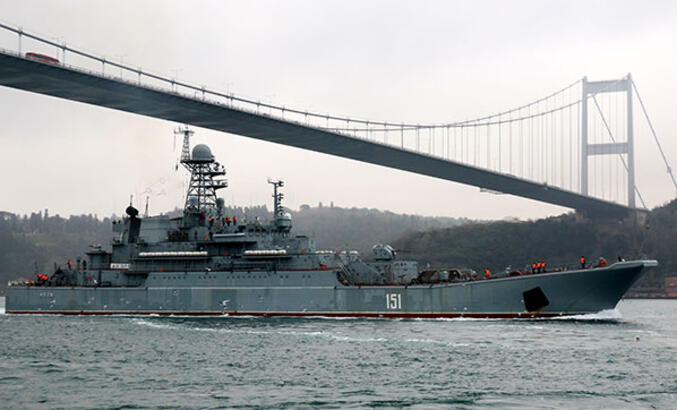| Four days into the Russian Federation’s invasion of Ukraine on February 27, 2022, Turkish Foreign Minister Mevlüt Çavuşoğlu declared that the operation in question was a “war.” He explained to CNN Türk, “Under these conditions, we will apply the Montreux agreement. Article 19 is pretty clear. In the beginning, it was a Russian attack and we evaluated it with experts, soldiers, and lawyers. Now it has turned into a war. This is not a military operation; it is officially a state of war.” The Turkish government has also sought to use the convention to de-escalate tensions in the Black Sea and, more broadly, has cautioned all countries not to send any warships into the Black Sea—perhaps to limit the possibility of Western maritime escalation. The implementation of Article 19 of the 1936 Montreux Convention could significantly impact Russian force projection into the Mediterranean Sea if the restrictions last for even a few weeks. Article 19 specifically regulates the passage of warships of belligerent powers through the Bosporus and Dardanelles straits—between the Black and Mediterranean Seas—when Turkey is not a party to the war. When such a war exists, Turkey may legally bar the passage of “vessels of war” belonging to the belligerents through the straits, excepting the allowance of those vessels to return to their home ports. As such, Russian Black Sea Fleet warships currently deployed outside the Black Sea may return north through the straits and non-Black Sea Fleet vessels currently in the Black Sea—such as the Baltic and Northern Fleet landing ships that arrived in early February—can depart. However, no further transfers of Russian warships through the straits would be permitted after that, for the duration of the war. Russian access to the Mediterranean Sea and beyond has significantly influenced Russian strategy for nearly all 325 years of the Russian Navy’s existence. Almost continuously contentious and bellicose Russo-Turkish relations under the old imperial regimes fomented a growing desire in the late nineteenth century—first among intellectuals and ultimately among Tsarist officials and diplomats—to annex the Bosporus and Dardanelles and rename Constantinople “Tsargrad.” During World War I, the Ottoman Empire closed the straits to the Russian Empire, denying access to British and French trade and supply—ultimately forcing the Allies to reroute aid to Russia via the Arctic and Far East. The Montreux Convention emerged following imperial contestation of the straits at the end of World War I and Turkey’s ultimate triumph in retaining them. After a century of doubt over the Turkish ability to retain the straits, the convention enshrined Turkey’s custody of them in international law. However, the convention also carved out several exceptions on ship movements of Black Sea powers designed specifically to appease the Soviet Union. The convention goes to great lengths to enable Black Sea Powers with ports outside the Black Sea to freely reposition warships—a benefit only Turkey itself and the Soviet Union could use. In recent years, the Russian government has leaned heavily on Turkey not to upset the compromises of the convention. Prior to the invasion of Ukraine, Russian Navy (VMF) ships frequently transited the Bosporus and Dardanelles. The overwhelming majority of these transits were conducted by ships of the Russian Black Sea Fleet, most often to relieve ships on patrol with Russia’s Mediterranean Squadron or to bring supplies to the Russian forces in Syria. Russian President Vladimir Putin established the current Mediterranean Squadron in 2013, operating from the Russian port facility in Tartus in Syria. Unlike other VMF units, the Mediterranean Squadron has no permanently assigned ships but instead rotates through ships deployed from each of Russia’s four fleets. These are typically ships of the Black Sea Fleet, though at the start of the 2022 invasion this fleet accounted for only five of the twelve Russian surface ships in the Mediterranean. If Turkey keeps the Bosporus and Dardanelles closed to the VMF for a long period of time, the most immediate impact would be on these two missions of maintaining presence and supplying operations both in the Mediterranean Sea and in Syria. The Russian Baltic, Northern, and Pacific Fleets would need to supply ships to the squadron much more frequently than they currently do. Though this would require considerably longer supply lines and likely shorter on-station times, it would not be an insurmountable challenge for the VMF. Indeed, at the time of writing, cruisers and other surface combatants from both the Northern Fleet and Pacific Fleet are deployed in the Mediterranean. However, delivering supplies by sea to the Russian forces in Syria may prove a greater challenge to offset. In addition to the reduced troop presence of the Operational Group of Forces in Syria, the Russian presence in Tartus maintains provisions for the Mediterranean Squadron itself. These supplies are typically delivered by Black Sea Fleet landing ships now bound to remain in the Black Sea. This tasking can be replaced by landing ships from other fleets, but the distances would be much greater. The distance between the main Russian Black Sea Fleet base at Sevastopol in Crimea is only 1,095 nautical miles from the port of Tartus. By contrast, the main Baltic Fleet base at Baltiysk, Kaliningrad Oblast, is approximately 4,200 nautical miles from Tartus, the main Northern Fleet base at Murmansk 4,900 nautical miles away, and the main Pacific Fleet base at Vladivostok 8,300 nautical miles away. Whereas Black Sea Fleet supply ships can transit between Sevastopol and Tartus in as few as four days, transiting from the nearest Russian port outside the Black Sea in Kaliningrad would require more than a week. In the short term, moreover, almost all Russian landing ships are deployed in the Black Sea to assist in the invasion of Ukraine. Furthermore, the Mediterranean Sea looms disproportionately large in VMF signaling. Though nearly 90 percent of VMF exercises reported by the Russian Ministry of Defence between 2014 and 2021 occurred in the seas immediately adjacent to VMF ports, more than 40 percent of VMF exercises reported in distant seas took place in the Mediterranean. Fourteen of the VMF’s thirty-two reported port visits in 2021 were in the Mediterranean Sea, including to NATO members Greece and Turkey and, especially, to European Union member Cyprus. Also significant is that the Black Sea Fleet is arguably the most modernized of Russia’s fleets in 2022. Following nearly twenty-five years of neglect during the time of Ukrainian control of Crimea and the various legal restrictions placed upon the recapitalization of the aging ships in Sevastopol, the VMF prioritized replacing the aging capabilities in the Black Sea Fleet after the annexation of 2014. As such, plenty of new small missile craft and Project 636.3 Varshavyanka-class diesel submarines have been commissioned into the Black Sea Fleet in the past eight years. Among ships that participate in exercises, in 2021 the average year in which a Black Sea Fleet vessel was commissioned was 1997 — excluding the Kommuna, a large rescue ship from 1915)—compared to 1996 for the Baltic Fleet, 1993 for the Northern Fleet, and 1982 for the Pacific Fleet. In addition to showing the age of VMF assets, these figures show that a closed Bosporus will keep the most modern Russian fleet confined to its home sea. Even a relatively short closure of the Bosporus and Dardanelles to the VMF would therefore likely entail significantly increased logistical costs to the maintenance of the last decade’s baseline Russian presence in the Mediterranean Sea. If Turkey keeps the straits closed for a longer duration—such as until Ukrainian territory is restored to Kyiv’s full control—this could raise serious questions about Russia’s ability to maintain the Mediterranean Squadron at all, due to competing strategic priorities in the Northern, Baltic, and Pacific Fleets. By: Nicholas J. Meyers Source: FPRI |
The significance of the Turkish Straits to the Russian Navy

Founded by a small group of Turkish/Kurdish scholars who have been subjected to persecution at the hands of the Erdogan dictatorship, News About Turkey (NAT) has emerged as a platform that is both exceptional and invaluable.
Our objective is to provide you with a comprehensive and sophisticated understanding of the events and developments in Turkey (Türkiye), a country with profound historical and geopolitical importance, a vibrant culture, and a strategic location.
Our founders, who have been purged by the Erdogan regime after the so-called coup attempt, are aware of the significance of journalism that is both free and independent. Because of this understanding, we are committed to providing reporting and analysis that is both objective and comprehensive. To give you the most thorough coverage of Turkey, we go further than just scratching the surface.
Keep in touch with us so that you can have a better understanding of Turkey's developing story as well as vital and comprehensive news items. Whether you are a resident of Turkey, a member of the Turkish/Kurdish diaspora, or simply someone who has a strong interest in this vital country, we are the most reliable source for news that not only informs but also inspires and engages you.
Leave a comment
Leave a comment


